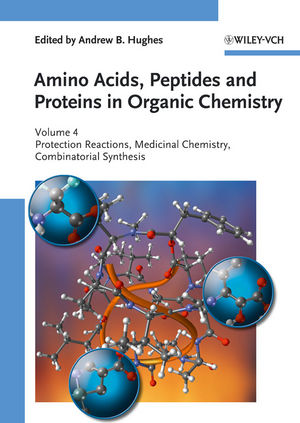Amino Acids, Peptides and Proteins in Organic Chemistry, Volume 4, Protection Reactions, Medicinal Chemistry, Combinatorial SynthesisISBN: 978-3-527-32103-2
Hardcover
552 pages
April 2011
 |
||||||
1 Protection Reactions (Vommina V. Sureshbabu and Narasimhamurthy Narendra ).
1.1 General Considerations.
1.2 α-Amino Protection (Nα Protection).
1.3 Carboxy Protection.
1.4 Side-Chain Protection.
1.5 Photocleavable Protections.
1.6 Conclusions.
1.7 Experimental Procedures.
References.
Part One Amino Acid-Based Peptidomimetics.
2 Huisgen Cycloaddition in Peptidomimetic Chemistry (Daniel Sejer Pedersen and Andrew David Abell ).
2.1 Introduction.
2.2 Huisgen [2 + 3] Cycloaddition Between Azides and Acetylenes.
2.3 Mechanistic Consideration for the Cu-Huisgen and Ru-Huisgen Cycloadditions.
2.4 Building Blocks for the Synthesis of Triazole-Modified Peptidomimetics.
2.5 Cyclic Triazole Peptidomimetics.
2.6 Acyclic Triazole Peptidomimetics.
2.7 Useful Experimental Procedures.
References.
3 Recent Advances in ß-Strand Mimetics (Wendy A. Loughlin and David P. Fairlie ).
3.1 Introduction.
3.2 Macrocyclic Peptidomimetics.
3.3 Acyclic Compounds.
3.4 Aliphatic and Aromatic Carbocycles.
3.5 Ligands Containing One Ring with One Heteroatom (N).
3.6 Ligands Containing One or Multiple Rings with One Heteroatom (O, S).
3.7 Ligands Containing One Ring with Two Heteroatoms (N,N).
3.8 Ligands Containing One Ring with Two Heteroatoms (N,S) or Three Heteroatoms (N,N,S or N,N,N).
3.9 Ligands Containing Two Rings with One Heteroatom (N or O).
3.10 Ligands Containing Two Rings with Two or Three Heteroatoms (N,N or N,S or N,N,N).
3.11 Conclusions.
References.
Part Two Medicinal Chemistry of Amino Acids.
4 Medicinal Chemistry of α-Amino Acids (Lennart Bunch and Povl Krogsgaard-Larsen ).
4.1 Introduction.
4.2 Glutamic Acid.
4.3 Conformational Restriction.
4.4 Bioisosterism,
4.5 Structure–Activity Studies.
4.6 Conclusions.
References.
5 Medicinal Chemistry of Alicyclic ß-Amino Acids (Nils Griebenow ).
5.1 Introduction.
5.2 Five-Membered Alicyclic ß-Amino Acids.
5.3 Six-Membered Alicyclic ß-Amino Acids.
References.
6 Medicinal Chemistry of a-Hydroxy-ß-Amino Acids (Zyta Ziora, Mariusz Skwarczynski, and Yoshiaki Kiso ).
6.1 Introduction.
6.2 α-Hydroxy-ß-Amino Acids.
6.3 Antibacterial Agents.
6.4 Inhibitors of Aminopeptidases.
6.5 Aspartyl Proteases Inhibitors.
6.6 Paclitaxel and its Derivatives.
References.
7 Peptide Drugs (Chiara Falciani, Alessandro Pini, and Luisa Bracci ).
7.1 Lights and Shades of Peptide and Protein Drugs.
7.2 Peptide Drugs Available on the Market.
7.3 Approved Peptides in Oncology.
7.4 Antimicrobial peptides.
7.5 Perspectives.
References.
8 Oral Bioavailability of Peptide and Peptidomimetic Drugs (Arik Dahan, Yasuhiro Tsume, Jing Sun, Jonathan M. Miller, and Gordon L. Amidon ).
8.1 Introduction.
8.2 Fundamental Considerations of Intestinal Absorption.
8.3 Barriers Limiting Oral Peptide/Peptidomimetic Drug Bioavailability.
8.4 Strategies to Improve Oral Bioavailability of Peptide-Based Drugs.
8.5 Conclusions.
References.
9 Asymmetric Synthesis of ß-Lactams via the Staudinger Reaction (Monika I. Konaklieva and Balbina J. Plotkin ).
9.1 Introduction.
9.2 Staudinger Reaction.
9.3 Influence of the Geometry of the Imine on Stereoselectivity in the Reaction.
9.4 Influence of the Polarity of the Solvent on Stereoselectivity of the Reaction.
9.5 Influence of the Isomerization of the Imine Prior to its Nucleophilic Attack onto the Ketene Stereoselectivity in the Reaction.
9.6 Influence of the Order of Addition of the Reactants to the Reaction.
9.7 Influence of Chiral Substituents on the Stereoselectivity of the Reaction.
9.8 Asymmetric Induction from the Imine Component.
9.9 Asymmetric Induction from the Ketene Component.
9.10 Double Asymmetric Cycloinduction.
9.11 Influence of Catalysts on the Stereoselectivity of the Reaction.
9.12 Conclusions.
References.
10 Advances in N- and O-Glycopeptide Synthesis – A Tool to Study Glycosylation and Develop New Therapeutics (Ulrika Westerlind and Horst Kunz ).
10.1 Introduction.
10.2 Synthesis of O-Glycopeptides.
10.3 Synthesis of N-Glycopeptides.
References.
11 Recent Developments in Neoglycopeptide Synthesis (Margaret A. Brimble, Nicole Miller, and Geoffrey M. Williams ).
11.1 Introduction.
11.2 Neoglycoside and Neoglycopeptide Synthesis.
11.3 Protein Side-Chain Modifications.
11.4 Cu(I)-Catalyzed Azide–Alkyne ‘‘Click’’ Cycloaddition.
11.5 Cross-Metathesis.
11.6 Application of Neoglycopeptides as Synthetic Vaccines.
11.7 Enzymatic, Molecular, and Cell Biological Techniques.
References.
Part Three Amino Acids in Combinatorial Synthesis.
12 Combinatorial/Library Peptide Synthesis (Michal Lebl ).
12.1 Introduction.
12.2 High-Throughput Synthesis of Peptides.
12.3 Synthesis of Peptide Arrays.
12.4 Peptide Libraries.
12.5 Future of Peptide Libraries.
12.6 Synthetic Protocols.
References.
13 Phage-Displayed Combinatorial Peptides (Renhua Huang, Kritika Pershad, Malgorzata Kokoszka, and Brian K. Kay ).
13.1 Introduction.
13.2 Conclusions.
References.
14 Designing New Proteins (Michael I. Sadowski and James T. MacDonald ).
14.1 Introduction.
14.2 Protein Design Methods.
14.3 Protocol for Protein Design.
14.4 Conclusions.
References.
15 Amino Acid-Based Dendrimers (Zhengshuang Shi, Chunhui Zhou, Zhigang Liu, Filbert Totsingan, and Neville R. Kallenbach ).
15.1 Introduction.
15.2 Peptide Dendrimer Synthesis: Divergent and Convergent Approaches.
15.3 Applications of Peptide Dendrimers.
15.4 Conclusions.
References.
Index.



